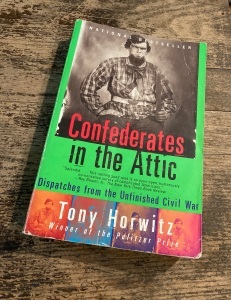Dirty Boots: “Confederates in the Attic,” Re-Visited
Though there is no timely anniversary to link this to, Tony Horwitz’s Confederates in the Attic: Dispatches from the Unfinished Civil War is a book begging for a mention right now. Published in 1998, it has become a classic of Southern studies. Roy Blount’s review in The New York Times called it the “freshest book about divisiveness in America that I have read in some time.” A little more than twenty-five years later, the cultural crosscurrents that the author explored at the end of the twentieth century have come all the way to fruition today.
 Most summaries say that the book is about Civil War re-enactors, but it’s certainly more than that. Horwitz started there but traveled all over the South, to cities and the countryside, to observe and talk with a variety of people. Unlike VS Naipaul’s approach for his 1988 exploration A Turn in the South, the writer didn’t stick to safe and tested sources of information that were set up for him in advance. In a town called Guthrie on the Kentucky-Tennessee line, Horwitz stopped at a local dive bar where one patron asked suspiciously whether he was with the FBI. He remarks on Vicksburg’s local museum being “the most eccentric” and “politically incorrect” site he had visited up to that point. The book’s final chapter opens with Alabama’s then-reinstated chain gangs on the highway, which the author saw as he drove into Montgomery. This sight incurred a few remarks on my hometown’s practice of billing itself, with no sense of irony, as both a Civil War and a Civil Rights history destination. Forget about the author’s conversation with a latter-day secessionist who lived in a black neighborhood in Charleston or that chapters are titled “The Civil Wargasm” and “Gone with the Window,” where else would you read that Shelby Foote would have preferred to just be a novelist?
Most summaries say that the book is about Civil War re-enactors, but it’s certainly more than that. Horwitz started there but traveled all over the South, to cities and the countryside, to observe and talk with a variety of people. Unlike VS Naipaul’s approach for his 1988 exploration A Turn in the South, the writer didn’t stick to safe and tested sources of information that were set up for him in advance. In a town called Guthrie on the Kentucky-Tennessee line, Horwitz stopped at a local dive bar where one patron asked suspiciously whether he was with the FBI. He remarks on Vicksburg’s local museum being “the most eccentric” and “politically incorrect” site he had visited up to that point. The book’s final chapter opens with Alabama’s then-reinstated chain gangs on the highway, which the author saw as he drove into Montgomery. This sight incurred a few remarks on my hometown’s practice of billing itself, with no sense of irony, as both a Civil War and a Civil Rights history destination. Forget about the author’s conversation with a latter-day secessionist who lived in a black neighborhood in Charleston or that chapters are titled “The Civil Wargasm” and “Gone with the Window,” where else would you read that Shelby Foote would have preferred to just be a novelist?
This book was one among several that set a high bar for examining the modern South as a harmlessly quirky but sometimes dangerous place with diverse local scenarios. Moving past white-authored Civil Rights memoirs, like Curtis Wilkie’s Dixie, which was published around the same time, Confederates in the Attic asked important questions in the 1990s: what came after the movement, and what’s going on down there now? The Civil Rights movement had changed everything. But it ended – according to historians – in the late 1960s, and harping on that bygone era wasn’t going to yield the kinds of new insights that the South needed in the late 1990s, and still needs now. The 1970s, ’80s, and ’90s were a period of change, of reconstruction, of evolution— but into what? Roy Blount also wrote in his review, “Most of the folks Horwitz meets are mellow, but in some cases geniality goes hand in hand with right-wing nuttiness.” (The Harvard professor who reviewed it for The Journal of Southern History also praised its off-the-beaten-path approach and commended Horwitz for his work, but used some of the word count to complain that there was no bibliography.) Put simply, Horwitz took a deep dive to find some answers firsthand. Yet, please don’t assume from my description that the answers are just sitting in this one book, waiting to be discovered. Works like this one are myth-busters that provide more questions than answers in the twenty-first century. Especially for the people who claim today that nothing has changed in the South.
 I know that I’m often wasting my time when I encourage people to read, or to learn about history, or to know facts. But this crazy South we live in sure does beg us to understand ourselves in ways that could lead us out of the craziness, not further into it. One of those lessons is that Southerners didn’t magically become who we are today (like, the day after Barack Obama was elected in 2008). We’d been working on our current incarnation for some time, and it’s a doozy! Politically, we’ve thrown our weight behind an orange-tinted real estate developer from New York City, a couple of culture-war governors, and their trickle-down henchmen in state legislatures. In some ways, I guess it’s no stranger than switching die-hard party affiliation that had lasted for more than a century to embrace an Orange County ex-movie star with a boy-next-door smile. In other ways, I would hope that we’d be slamming on the collective brakes and gasping, Wait—what have we done? I’m straying off my main message, but I am actually trying to make a point: if Southerners understood our own past better, we might not make so many bad choices in the present.
I know that I’m often wasting my time when I encourage people to read, or to learn about history, or to know facts. But this crazy South we live in sure does beg us to understand ourselves in ways that could lead us out of the craziness, not further into it. One of those lessons is that Southerners didn’t magically become who we are today (like, the day after Barack Obama was elected in 2008). We’d been working on our current incarnation for some time, and it’s a doozy! Politically, we’ve thrown our weight behind an orange-tinted real estate developer from New York City, a couple of culture-war governors, and their trickle-down henchmen in state legislatures. In some ways, I guess it’s no stranger than switching die-hard party affiliation that had lasted for more than a century to embrace an Orange County ex-movie star with a boy-next-door smile. In other ways, I would hope that we’d be slamming on the collective brakes and gasping, Wait—what have we done? I’m straying off my main message, but I am actually trying to make a point: if Southerners understood our own past better, we might not make so many bad choices in the present.
Sadly, Tony Horwitz left us in May 2019, at the age of 60, but before he died, he contributed one more book on our region: Spying on the South. In that one, he followed the path that Frederick Law Olmsted once wandered. If I manage to convince a few folks to read one book, I may as well throw down the gauntlet and suggest reading two. But if even one is too much to ask . . . I’ll say this: the next time you feel like, Things sure are crazy these days, just remember that they have been for quite some time.



